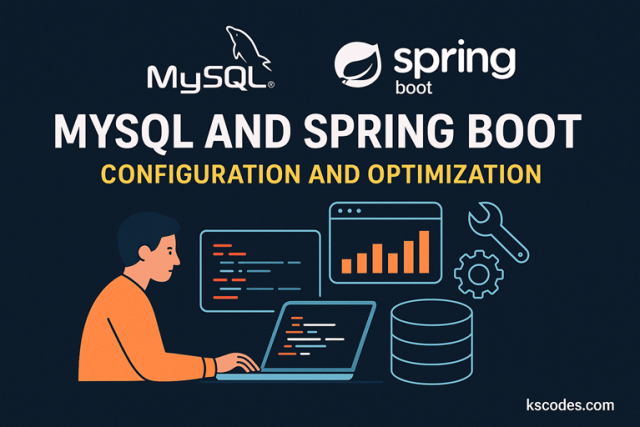Integrating MySQL with Spring Boot is a common setup for building robust backend systems. However, just getting the connection to work is not enough — real-world applications demand reliability, speed, and scalability. This post explores Spring Boot MySQL performance tuning along with setup best practices.

🧩 Why MySQL + Spring Boot?
MySQL is widely adopted for its:
- Ease of setup
- Strong community support
- Compatibility with JPA and Hibernate
- Support for ACID transactions and replication
Spring Boot’s auto-configuration makes it a natural pairing, simplifying boilerplate code while allowing fine-grained control over performance.
📦 Project Setup
1. Add Required Dependencies
In pom.xml:
|
1 2 3 4 5 6 7 8 9 10 11 12 13 |
<dependency> <groupId>org.springframework.boot</groupId> <artifactId>spring-boot-starter-data-jpa</artifactId> </dependency> <dependency> <groupId>mysql</groupId> <artifactId>mysql-connector-java</artifactId> <scope>runtime</scope> </dependency> |
🔧 Configuring application.yml
|
1 2 3 4 5 6 7 8 9 10 11 12 13 14 15 16 |
spring: datasource: url: jdbc:mysql://localhost:3306/myapp_db?useSSL=false&serverTimezone=UTC username: root password: root driver-class-name: com.mysql.cj.jdbc.Driver jpa: hibernate: ddl-auto: update show-sql: true properties: hibernate: dialect: org.hibernate.dialect.MySQL8Dialect |
This sets up a standard database connection. Let’s now enhance it with Spring Boot MySQL performance tuning strategies.
🚀 Performance Tuning Tips
1. Connection Pooling with HikariCP
HikariCP is the default pool in Spring Boot 2.0+ and it’s very fast. Customize it:
|
1 2 3 4 5 6 7 8 9 10 11 |
spring: datasource: hikari: maximum-pool-size: 10 minimum-idle: 5 idle-timeout: 30000 max-lifetime: 1800000 connection-timeout: 20000 |
2. Indexing Your Tables
In MySQL, always index columns used in WHERE, JOIN, and ORDER BY clauses.
|
1 2 3 4 |
CREATE INDEX idx_user_email ON users(email); |
3. Avoiding N+1 Problem
Use @EntityGraph or JOIN FETCH in queries to fetch associated entities efficiently.
|
1 2 3 4 5 |
@Query("SELECT u FROM User u JOIN FETCH u.roles") List<User> findAllWithRoles(); |
4. Batch Inserts/Updates
Enable batch processing to minimize DB round-trips:
|
1 2 3 4 |
spring.jpa.properties.hibernate.jdbc.batch_size: 30 |
🧪 Monitoring and Observability
Use tools like:
- Spring Boot Actuator for metrics
- MySQL Slow Query Log for identifying bottlenecks
- JProfiler / VisualVM for JVM monitoring
✅ Best Practices
- Avoid using
ddl-auto=updatein production - Use Flyway or Liquibase for migrations
- Prefer pagination over full dataset retrieval
- Isolate read/write queries if scaling horizontally
🧩 Conclusion
Setting up MySQL with Spring Boot is straightforward, but Spring Boot MySQL performance tuning helps ensure the system performs efficiently under load. By optimizing connection pooling, queries, and Hibernate behavior, you make your app more scalable and responsive.